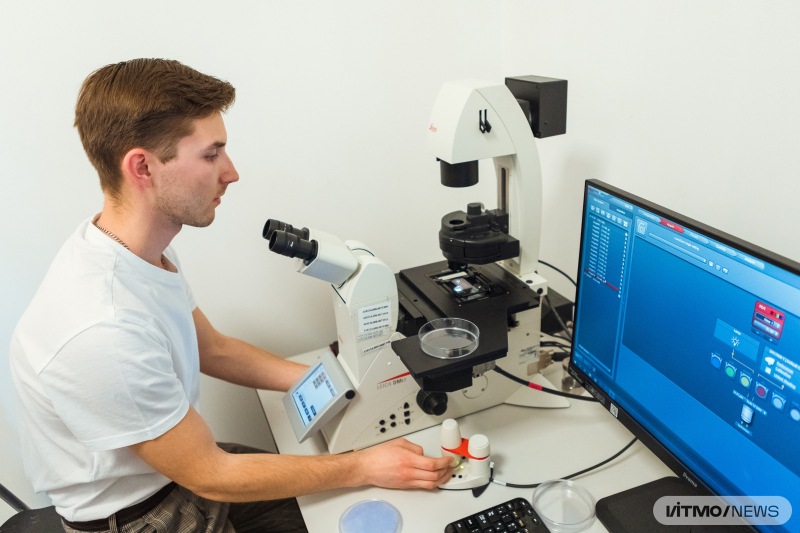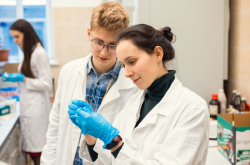Contents
- What is SCAMT Workshop Week
- How to get in
- КSchool structure
- How to apply what you learned at SCAMT
- Other opportunities offered by SCAMT Workshop Week
What is SCAMT Workshop Week
SCAMT Workshop Week is a school hosted by the university’s SCAMT Institute twice a year. At the event, participating students attend lectures by experts in different fields, including genetics, molecular and cell biology, chemistry, nanotechnologies, and others. Apart from soaking in all the knowledge and visiting the university’s laboratories, the participants choose one project they will be working on with a supervisor – a scientific study or an industrial case (creating a digital service or a startup).
As a result, students get the chance to enroll into one of the following Master’s programs without exams:
- Applied Genomics;
- Molecular Biology and Biotechnology;
- Chemistry and Artificial Intelligence;
- Sustainable Chemistry for Energy Technologies.
What’s more, students can do an internship at the university’s ChemBio Cluster that will result in a research article or a startup with support from experts of the SCAMT Institute.
Olesya Melnikova, the workshop’s curator, preparing an environment for bacterial cultivation with workshop participant Alexander Bobko. Photo by Dmitry Grigoryev / ITMO.NEWS
How to get in
The school welcomes Russian and international Bachelor’s and Master’s students. Your application should include a CV and a letter of motivation.
Your CV has to include information about your education (university degree(s) and any additional certificates), field of interest, experience of participating in research grants and conferences, your publications, as well as the hard skills you are planning to rely on when developing your project at SCAMT.
In your letter of motivation, you should explain why you want to take part in SCAMT Workshop Week, explain your choice of the project, describe the soft and hard skills you will use during the event, as well as how you are planning to use the experience you’ll gain in the future.
The latest, 10th school, received 330 applications, with 67 participants from all over Russia making it through the selection process.
See also:
New Materials, Nanotoothpaste, and Electric Bacteria: Outcomes of Eighth SCAMT Workshop Week
Participant Olesya Ivankova weighing components for a nutrient medium. Photo by Dmitry Grigoryev / ITMO.NEWS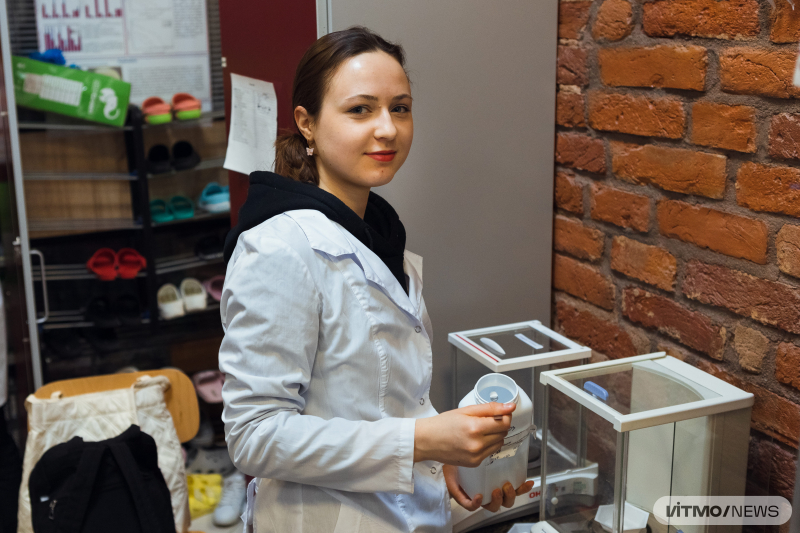
School structure
This year, participants can choose to join one of the three tracks based on the main focus areas of the institute: industrial projects, applied solutions for labs, or AI-based technologies in biology and chemistry.
The experimental track is for those interested in wet chemistry. Some of the projects you can engage in are (all links are in Russian apart from the last one):
- Studying next-in-class BCR-ABL1 inhibitors through in vitro experiments on cell cultures. These drugs can lower the tolerance of tumor cells, improving the efficiency of treatment of chronic myeloid leukemia.
- Developing an omniphobic chip that repels water and lipids. These come in handy in the lab: on their surface, you can place hundreds of drops and conduct separate biomedical analyses with each of them.
- Creating a unique pattern that will protect any product from fraud.
- Synthesizing hollow metal capsules and introducing them into anodic metals for printing flexible electronics.
- Growing producers of antimicrobial compounds and studying how efficiently they kill bacteria.
- Exploring electrochemical methods and the ways they help alleviate global warming.
- Developing a producer of spider silk – first, digitally, and then in vitro. Its applications vary from making clothes to producing expendable medical materials.
- Creating DNA structures that can detect nucleic acids for various applications, including diagnostics.
- Designing a DNA nanomachine for virus detection and elimination.
A project team conducting electrophoresis on nucleic acids. Photo by Dmitry Grigoryev / ITMO.NEWS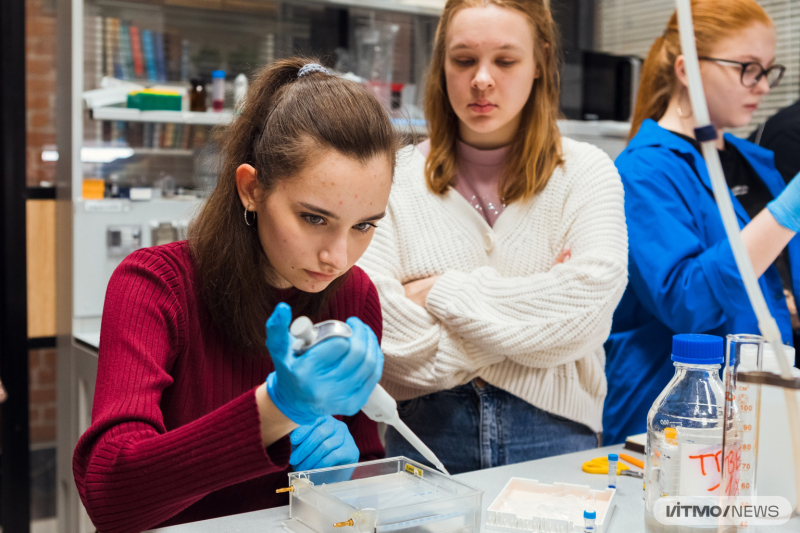
The digital track will be a great choice for students who want to learn to apply AI and machine learning in biology and chemistry. Within this track, the participants will study R and Python, the TransposonUltimate package for transposon identification, and the Jellyfish 1.1.4 tool for k-means analysis. All of these can be applied in the following projects (links in Russian):
- Studying the effects of transposons (DNA sequences capable of moving and multiplying within a genome) on the evolution of the body’s genome and chromosomes.
- Studying the genetic mechanisms of aging prevention in naked mole-rats in order to provide solutions that can increase human life expectancy.
- Developing a model for the generation of active molecules to treat rare diseases.
- Designing a service capable of predicting the electrical characteristics of sodium-ion batteries in order to produce a substitute for the lithium-ion batteries.
- Building a model predicting the magnetic properties of nanoparticles for therapeutic hyperthermia and MRI contrasting agents.
An omniphobic chip with living cells developed by workshop participants. Photo by Dmitry Grigoryev / ITMO.NEWS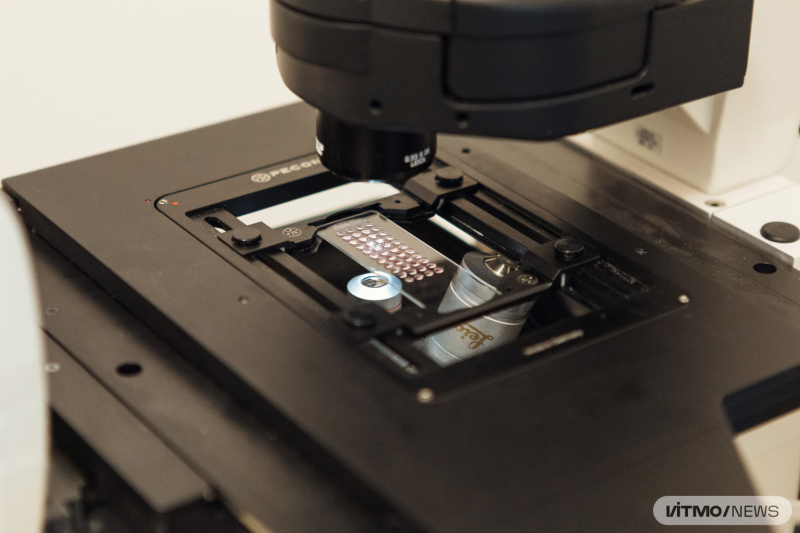
The industrial track is meant for those students who already have an idea for a startup but need additional skills in product development and bringing their technology to the market. Within the track, students will formulate their concept and work through its commercial aspects (building a business model, conducting financial analysis, etc.). As a result, students will come up with an MVP connected with (links in Russian):
- Their own business idea;
- Developing multiparameter testing systems for agriculture, medicine, ecology, or other fields;
- Developing indicator materials.
At the latest SCAMT Workshop Week, each track featured up to nine projects. When applying to the school, students could pick one track and three projects they would like to work on. Those who passed the selection were sorted into teams where they worked on a project within their chosen track.
Apart from that, students attended lectures by experts from the SCAMT Institute, BIOCAD, and the Saint Petersburg Stieglitz State Academy of Art and Design, where they learned about the current research and diagnostics methods, data visualization, preparing and promoting scientific publications, as well as developing their ideas into full-scale products.
Workshop participants studying cell vitality with an automatic fluorescence microscope. Photo by Dmitry Grigoryev / ITMO.NEWS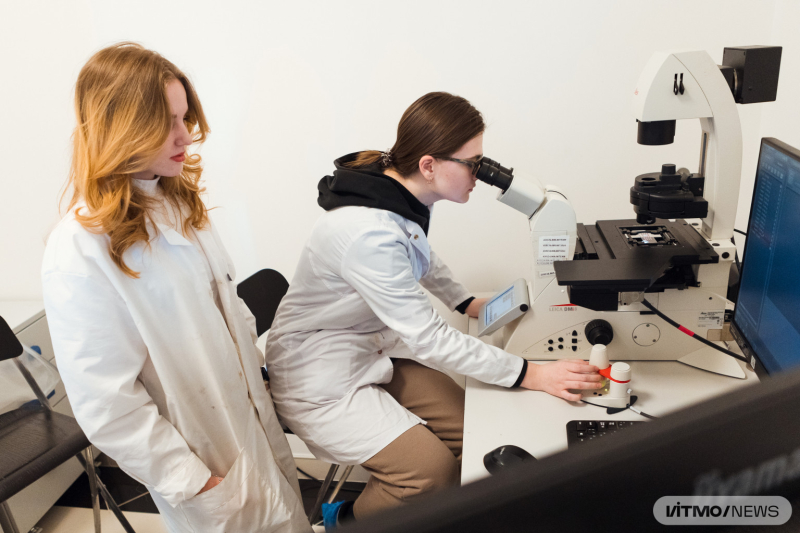
How to apply what you learned at SCAMT
You can publish the results of your research. For instance, Arina Dushankova, a fourth-year student from Saratov State University’s Institute of Chemistry, plans to do just that after participating in the school’s digital track. At her home university, she studies Python and machine learning algorithms. At ITMO, she worked on the project Predicting the Magnetic Properties of Nanoparticles.
“In a week, we determined the main criteria of efficiency and built a model to predict the magnetic properties of nanoparticles. That way, we can synthesize nanoparticles with the desired properties while saving valuable time and raw materials. In the future, I plan to use the methods I learned at SCAMT in my own research. My thesis concerns the development of highly sensitive analytical systems based on luminescent and hybrid quantum nanoparticles. Such a system could be used to quickly calculate the residual concentration of antibiotics after cancer therapy. One would simply need to add a quantum dot to any biological fluid (for instance, blood). The intensity of that dot’s glow would correspond with how much medicine remains in the fluid. The model we’ve created will make it easier to properly process the data derived from optical spectra, select parameters, and predict the properties of samples in the future,” shares Arina Dushankova.
Arina Dushankova. Photo by Dmitry Grigoryev / ITMO.NEWS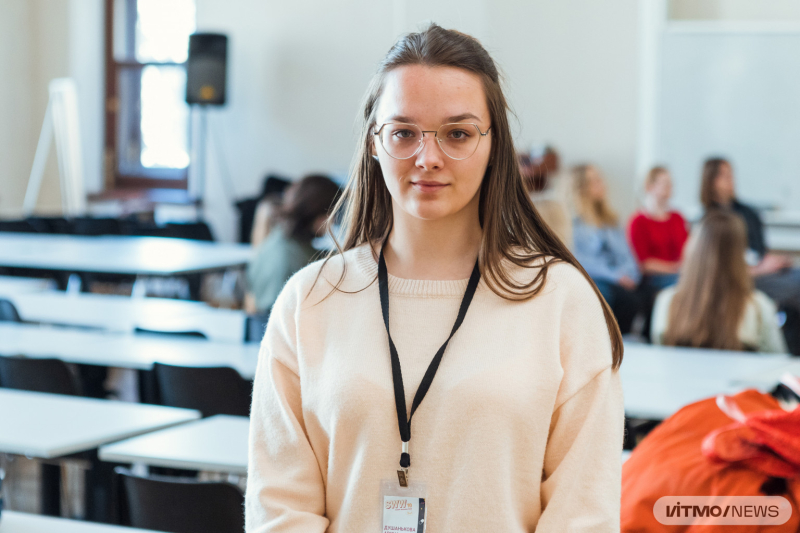
See also:
ITMO Researchers Develop First-Ever Online Platform For Nanozyme Modeling
You can use your new practical skills to further develop your own research. That is the intention of Daria Malysheva, a fourth-year student of Novosibirsk State University’s Department of Natural Sciences and a participant of the experimental track. At the Institute of Chemical Biology and Fundamental Medicine of the Siberian Branch of the Russian Academy of Sciences (ICBFM SB RAS), she is part of an effort to develop a targeted drug for boron neutron capture cancer therapy. According to Daria, this method only affects the tumor cells and is harmless to healthy tissue. It delivers an isotope of boron-10 inside the tumor which is then destroyed via epithermal neutron radiation.
“My research utilizes similar methods to those of Ahmed Eldeeb, the head of a frontier laboratory at SCAMT whose team is responsible for creating advanced cancer treatments. At ICBFM SB RAS, we work with aptamers – short oligonucleotides (DNA or RNA molecules – Ed.) that are capable of binding with a specific tumor molecule while carrying the boron isotope. ITMO scientists work with the same short oligonucleotides, developing DNA nanomachines that can solve simple logical operations and interact with cells in a complex manner. Such devices may be used in both diagnostics and therapy. For example, the nanomachines could give off a signal if they locate and bind with a molecule which is symptomatic of some disease, or they could cleave the RNA of certain cells to decrease their survivability. It was helpful to discover new applications for familiar methods and technologies and improve my lab equipment handling skills. We learned how to design both simple and complex DNAzymes (catalytic single-sequence DNA molecules capable of cleaving RNA targets), and analyzed how various structural changes affected their efficiency,” tells us Daria Malysheva.
Daria Malysheva. Photo by Dmitry Grigoryev / ITMO.NEWS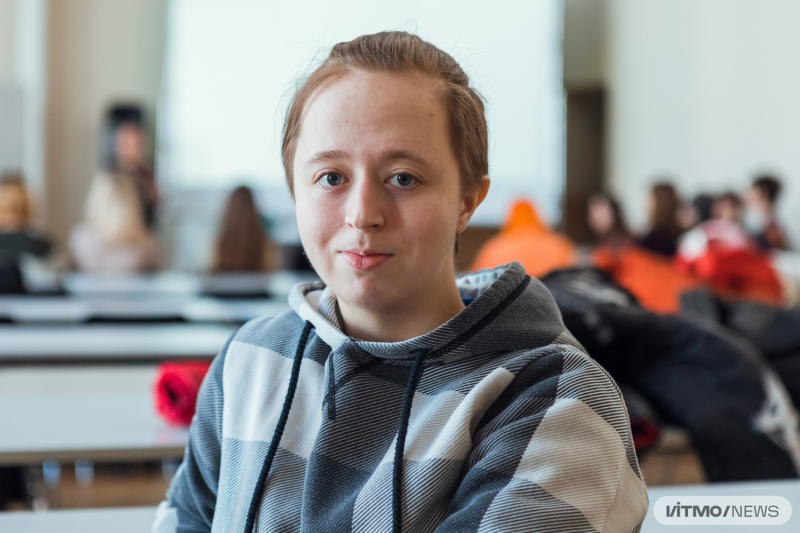
See also:
ITMO Researchers Create Virus-Detecting DNA Bot
ITMO Fellow Ahmed Eldeeb on Working in Russia and Becoming a PI at 28
You can develop an idea for your startup. According to Zinaida Krasovskaya, a fourth-year student at the Ivanovo State University of Chemistry and Technology’s Faculty of Inorganic Chemistry and Technology and a participant of the industrial track, her work at SCAMT helped her to develop her own project while improving her entrepreneurial skills. At the G.A. Krestov Institute of Solution Chemistry of the Russian Academy of Sciences, she researches fluorescent sensors of zinc cations and creates testing systems for their quick detection. This technology could be used in various fields – for example, it can analyze wastewater for pollution in ecology, or monitor health threats in medicine.
“At SCAMT Workshop Week we developed our ideas into startups and created business plans. We analyzed existing papers and devices, sought out our target audience, and formulated our solutions’ selling points, costs, and timeframes. Studying at SCAMT helped me make a shift from being a researcher to something more of an entrepreneur. While both types of people have a knack for creative problem solving, the latter take more risks, so they have to think two steps ahead. It felt great to have professionals like Aleksandr Ulesov, the head of SCAMT Startup Factory, share their experiences and provide relevant advice,” comments ZInaida Krasovskaya. “I will continue working on my project, since it was of great interest to the audience. From the beginning, ITMO was my top choice for Master’s studies. SCAMT has great vibes, and people here come up with amazing ideas that they then convert into reality. Without such people, no lab, no matter how well-equipped, can produce results.”
Zinaida Krasovskaya. Photo by Dmitry Grigoryev / ITMO.NEWS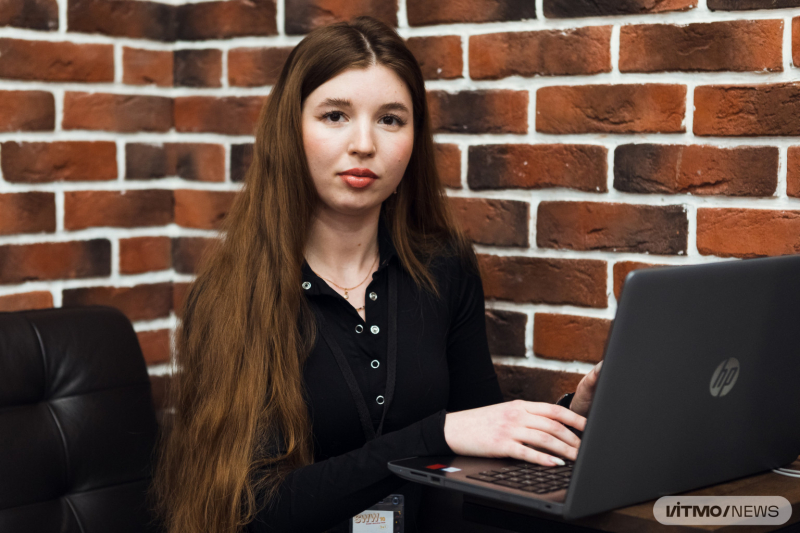
See also:
Other opportunities offered by SCAMT Workshop Week
After the school’s conclusion, the participants may complete an internship at one of SCAMT’s laboratories, the choice of lab depending on the project that they worked on during the week. The length of each internship is discussed with the participants individually by project curators.
Additionally, if the participant attended every lecture, was an active part of their project team, and successfully defended the results of their work, they may apply for one of SCAMT’s Master’s programs without the need to take entrance exams:
